| کد مقاله | کد نشریه | سال انتشار | مقاله انگلیسی | نسخه تمام متن |
|---|---|---|---|---|
| 6024845 | 1580888 | 2015 | 9 صفحه PDF | دانلود رایگان |
Neuronal oscillations provide an efficient means of communication, fostering functional neural states supporting action and reaction. High in the action hierarchy, cognitive abilities are severely compromised in neuropsychiatric disease such as schizophrenia. Current thinking highlights a clocking mechanism provided by the phase of an ongoing slow oscillation that offers a temporal frame for coding of perceptual and computational elements. Yet unclear is whether and how a dysregulated clocking mechanism accounts for diminished cognitive performance. Neuromagnetic oscillatory activity was related to cognitive performance assessed by the MATRICS Consensus Cognitive Battery in 58 healthy individuals (HC) and 46 schizophrenia patients (SZ). HC showed a correlation between gamma-band oscillations (>Â 40Â Hz) and working memory performance. This relationship was disrupted in several ways in SZ. First, patients evidenced lower gamma power, poorer working memory performance, and no relationship between these measures. Second, the power spectra were dominated by ~Â 10Â Hz alpha oscillations with no group differences in amplitude. However, analysis of phase-to-amplitude coupling (PAC) revealed exaggerated clocking of gamma activity by alpha phase in SZ, associated with poor working memory performance. Third, despite entrainment by the same 10Â Hz clock, gamma amplitude was abnormally distributed across the duty cycle in SZ, a potential consequence of compromised interneuron inhibition. Fourth, SZ showed over-engagement of a fronto-parietal network measured by gamma phase coherence, suggesting a brain state hindering cognitive output.Such an endogenous temporal organization may be a core dysfunction in SZ: a segregation/integration input imbalance fostering reduced cognitive performance and compromised behavioral output.
Journal: NeuroImage - Volume 119, 1 October 2015, Pages 316-324
